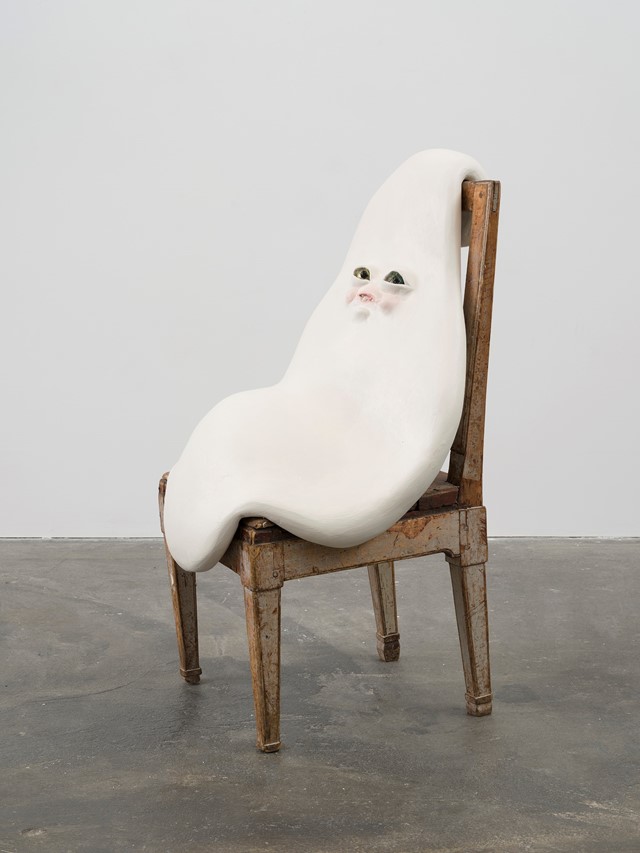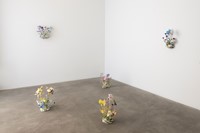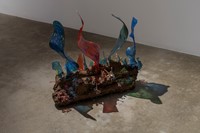Lust, loneliness and exhaustion: the artist duo talk us through their strange and enchanting new LA exhibition, A Pancake Moon
The scrappy, lurid and fantastical world of Swedish artist duo animator and sculptor Nathalie Djurberg and musician Hans Berg is visited anew with A Pancake Moon – the artists’ first solo show in Los Angeles since 2008.
After a recent collaboration with Miu Miu on a jewellery project for Autumn/Winter 2022 (Miuccia Prada is a fierce champion of the pair, having shown their work at Fondazione Prada since 2008) and in the light of the Roe v Wade overturning earlier this year, the pair’s investigation of our bodily autonomy plumbs further depths. In a collaboration of Djurberg’s stop-motion animation and sculpture-filled immersive installation and Berg’s surreal soundscapes, dishevelled folkloric animals morph and meld in unsettling puddles of base emotions.
This time, beyond a lollipop vortex curtain is a forest of glass flora and putty fauna (including poached eggs looming on chairs) where the show’s central film explores a playful metaphor for motherhood: a plasticine egg (full of potential) engages in a push-and-pull dance with a ferocious bear and a wolf, both of whose love and desire for the egg threatens to segue into a carnivorous devouring. The egg becomes a moon (an orb-like being, its own, “self-obsessed” planet) as it struggles with exhaustion and loneliness before eventually deflating into an empty pancake.
Absurd yet enchanting, the delightfully disturbing setting enhances the artists’ well-loved, mysterious magic. Here, the artists talk to Sophie Bew about their journey through the work.
Sophie Bew: How did this piece come about?
Nathalie Djurberg: I wasn’t pregnant anymore.
Hans Berg: No, and that’s why this was so difficult, because you thought you would have so much time and your baby would just lay still and watch you work, and that didn’t really happen.
ND: And that was how it came about, I got myself pregnant, I was pregnant, and then I was pulled into looking at myself again and how I was working.
SB: Can you talk us through the narrative a little? The symbolism of the egg-tuned-moon-turned-pancake as representative of motherhood?
ND: The egg was the potential, the before, and the moon was the pregnancy. It was funny because I had recently read about someone being disgusted with the self-importance of pregnant woman, and that was exactly how I felt – among a million other more uncomfortable things – but the idea of being on a planet of your own, self-absorbed, moving and changing, untouchable.
Then I got really stupid, my mind imploded and I couldn’t remember the end of a sentence, what I was worrying about, and what the next step was. I became a being, living from moment to moment, and I could no longer have an intelligent conversation with anyone.
HB: The exhibition is also so much about control, the loss of control over your body, or your perceived control. Some of the sculptures in the exhibition, which are wood-men with wooden hard-ons, explore the bodily functions that one can’t control, you just sit and watch it happen to you. Sometimes these are attached to feelings of shame, especially if it’s something considered inappropriate. Obviously I can’t connect to the motherhood aspect of the work, but there are many themes that apply to everyone.
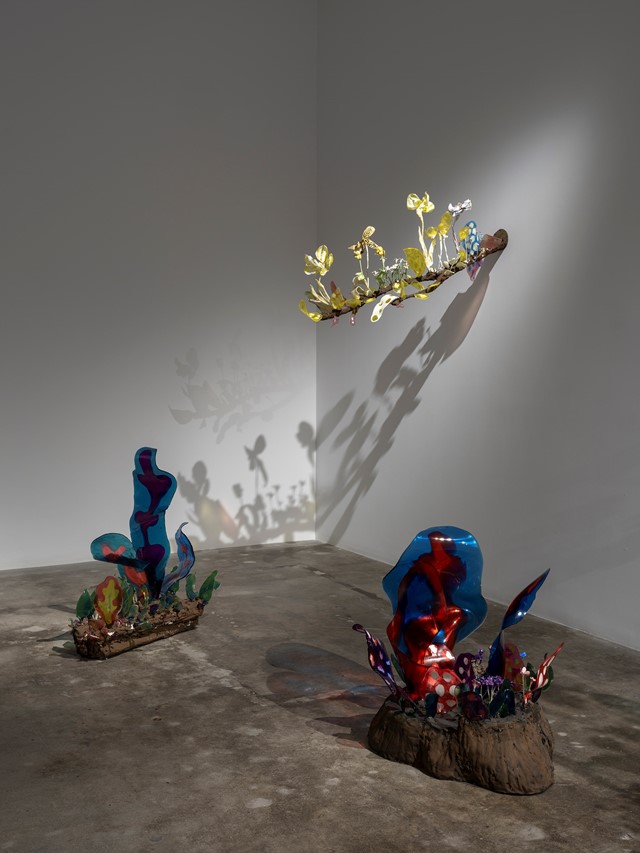
SB: A sort of devouring lustiness appears often in your work – why do you think that is?
ND: Because there is lust in so many parts of being, the body lusts and so does the mind, if it’s not for sex it’s for alcohol, drugs, fame, comfort, anything. We are like an empty pit, and the emptiness creates a sense of lacking, or not being enough. Naturally, we want to try and fill that hole with something. We often want the wanting itself, because we are so used to it, that to be without it, we feel emptiness. But sex, and lustiness in sex is what transfers best in the animations, even one animation that isn’t necessarily about lust for me, can use the same language, to portray a different kind of lust.
SB: Would you describe many of your works as personal? Or universal?
ND: Both. As a human I am unique just like everyone else. That is the beauty of humanness and the language that reflects on it. What I have experienced has been experienced by countless others in a slightly different, unique way. Experiencing each other’s perspective through art forms, we are able to visualise their experience.
HB: Yes, it is when you can connect to the art on a personal level, that it becomes most interesting.
SB: There’s a fairytale element to the film – balletic in places – can you talk about that?
HB: I think this often comes from childhood memories, and that is where we find the core and our basic instincts being shaped and formed. For this we often refer back to the fairytale as a caution, a reflection, a perspective, which we can all recall, or perceive.
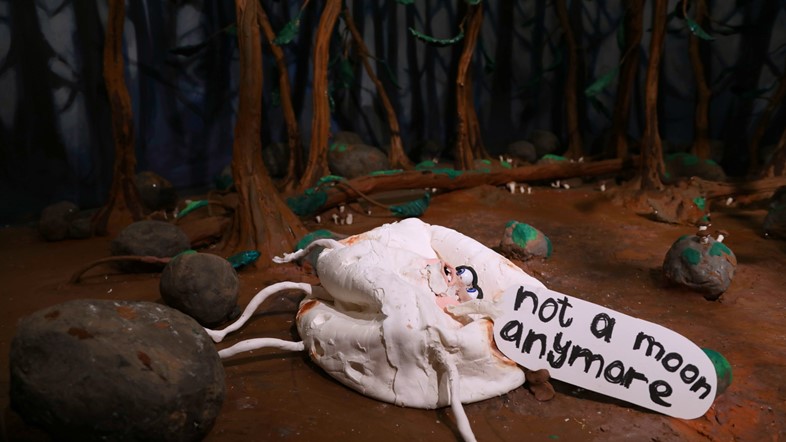
SB: Your work often plays on the graphic, visceral nature of impulses and emotions – how did this become your language?
ND: Once I found animation, I felt it was my medium instantly, in the sense that I completely gave up finding other ways of expression. I just kept on animating and finding new ways to do it and through that self-learning process of the medium. It was in the psychology and emotion of the process, which I have now done for so long that I can’t distinguish the edges. It just is, and couldn’t come out different,and that is why it works so well to work with Hans because he became a musician in the same way.
HB: Yes, my music is often a direct emotional response to the films, sculptures or just by itself. I have learned how to fine-tune that response, a self-learning process just like Nathalie, but the original source is still the same, it’s my language, and how I express best. We both work naturally and intuitively.
SB: What about your influences and training have led you to your distinctive aesthetic and sound? And how do you describe it to anyone unfamiliar with your work?
HB: Preferences. Basically preferences are what the ego is made out of, what makes us us. So from everything that we encounter, the things that we like stick, influence us and slip into our minds and then out through our own work. Therefore it’s really hard to describe it to anyone unfamiliar with the work, because to us it seems so natural and just the way we think and work, we don’t have any outside perspective so it’s difficult to describe.
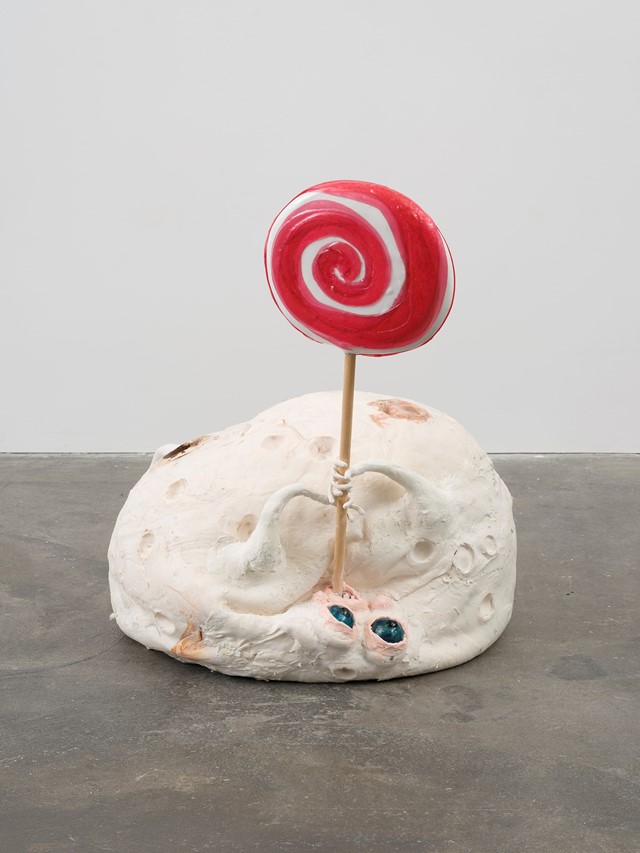
SB: Why do you think you are both drawn to the mediums you use?
HB: I can express myself effortlessly with music. I’ve tried other mediums but this is the best way for me to both receive and give, to connect on the deepest level. And electronic music because, alone in my studio, I can make a piece that fills up the whole audible sound spectrum, from the deepest basses that really shake your body, to the highest tones. I use electronic instruments to sculpt the sound in a very visceral way.
ND: In animation I don't have to have one image stand by itself but I can work with what happens. I am spellbound by the life the animation takes on by itself. Even though I made sculpture before starting animation, it was animation that made me find purpose in sculpture once more.
SB: Nathalie, can you talk about why the body is so important to your work? Why are you interested in physicality in the way you are?
ND: We are physical, that is how we experience the world. And what is hard to digest, for us, gets stuck in the body as trauma and the mind takes over telling the story of it. In making the art, I am once more re-experiencing and experiencing what I wasn’t aware of before, playing it out and seeing it through the lens of myth and riddle.
SB: How will viewers experience watching it in the show?
ND: However they will, there is no controlling an experience in another person and we have no interest in trying to make someone experience a specific thing, but we would hope there is a resonance with those who see it, that it strikes a note or recognition or a whisper, like a secret.
A Pancake Moon by Nathalie Djurberg and Hans Berg is on at at Tanya Bonakdar Gallery in LA until 21 January 2023.
